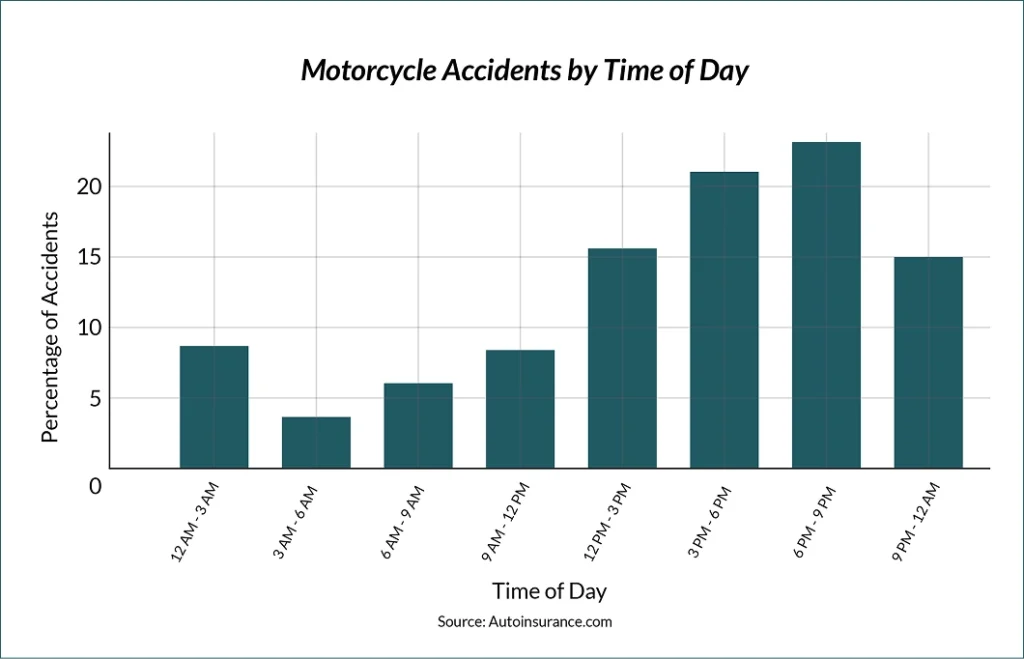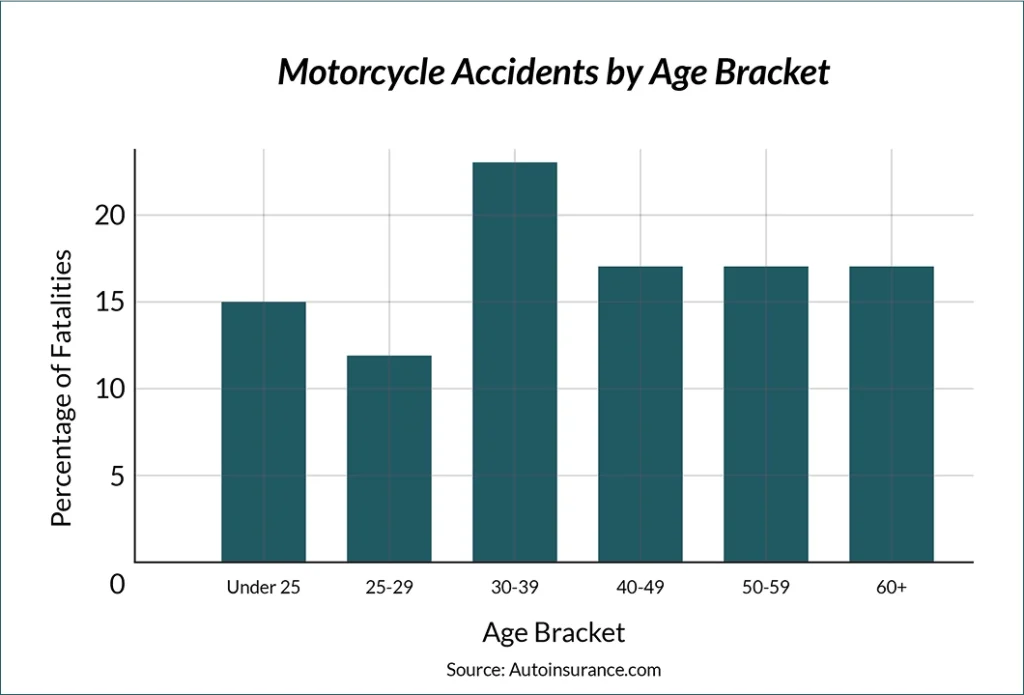Motorcycle Safety:
Understanding the Risk Through Statistics
Riding a motorcycle offers a thrilling sense of freedom and adventure, but it also comes with serious risks. Unlike enclosed vehicles, motorcycles provide minimal protection in a crash, making safety a top priority for every rider. By understanding the real dangers of the road and learning how to avoid them, bikers can take control of their safety.
At Feller & Wendt, LLC™, we believe that knowledge is power when it comes to motorcycle safety. This guide brings together the latest statistics and expert insights to help riders make informed choices. Whether you are a seasoned biker or just starting out, understanding the data can make a life-saving difference.
Table of Contents
- Motorcycle Accidents: By the Numbers
- How Weather Conditions Impact Motorcycle Safety
- The Importance of Wearing Protective Gear
- Speeding: A Leading Factor in Motorcycle Accidents
- The Risks of Riding a Motorcycle at Night
- Fatigue and Motorcycle Safety: The Dangers of Riding While Tired
- Distracted Driving: A Growing Concern for Motorcyclists
- Age and Its Impact on Motorcycle Safety
- Safety Tips for Beginner Motorcyclists
- Road Safety Tips Every Motorcyclist Should Know
- Practice Driving Safely
Motorcycle Accidents: By the Numbers
Motorcycles make up only a small percentage of vehicles on the road, yet they are involved in a disproportionately high number of serious accidents and fatalities. These motorcycle safety statistics from the National Highway Traffic Safety Administration provide a clear view of the risks riders face:
- Motorcyclists are 28 times more likely to die in a crash per vehicle mile traveled than passenger car occupants.
- They are 5 times more likely to be injured in a crash per vehicle mile traveled.
- In 2023, there were 6,335 motorcyclists killed in traffic crashes. This represented 15% of all traffic fatalities.
- Motorcycle crashes accounted for 14% of all traffic fatalities, despite motorcycles making up only about 3.5% of registered vehicles.
The severity of injuries in motorcycle accidents is also much higher than in other types of crashes. Even low-speed collisions can result in broken bones, head trauma, or long-term disability.

How Weather Conditions Impact Motorcycle Safety
While poor weather can increase the risk of motorcycle accidents due to reduced traction and visibility, it often leads riders to be more cautious or avoid riding altogether. Rain, fog, and extreme cold temperatures can make conditions dangerous, but many motorcyclists recognize these hazards and adjust their behavior accordingly.
The real weather-related dangers are often the ones you don’t see coming. For instance, extreme heat is frequently underestimated. It can compromise tire performance by causing overinflation, reducing grip, or increasing the risk of blowouts, especially on long rides or poorly maintained roads.
Interestingly, data from the National Safety Council shows that 94% of motorcyclist fatalities in 2021 occurred during good weather. This suggests that the real risk often arises during ideal riding conditions. When the weather is clear, more bikes are on the road, and riders may develop a false sense of security. This can lead to higher speeds, riskier maneuvers, or reduced vigilance.
The perception of safety can be as dangerous as the weather itself. Never let favorable weather replace safe riding practices. Checking forecasts, wearing appropriate gear, and staying alert are critical no matter the conditions.
The Importance of Wearing Protective Gear
Wearing proper protective gear is one of the most effective ways motorcyclists can reduce the severity of injuries in a crash. Motorcyclists do not have a metal frame, airbags, or seatbelts to protect them. That’s why high-quality safety gear is essential every time you ride.
According to the National Safety Council, helmets are estimated to be 37% effective in preventing fatal injuries to motorcycle operators and 41% effective for passengers. Yet, many riders still choose not to wear them. States with universal helmet laws tend to have lower fatality rates than those without helmet laws.
Safety gear, such as jackets, gloves, boots, and reinforced pants, is critical. These items can prevent road rash, reduce the impact of collisions, and provide insulation during harsh weather. Body armor, especially in jackets and riding suits, can protect against spinal injuries and blunt force trauma.

Speeding: A Leading Factor in Motorcycle Accidents
Speeding is one of the most common and dangerous behaviors motorcyclists can engage in. According to NHTSA, speeding contributed to 33% of all fatal motorcycle crashes in 2021. Higher speeds increase the likelihood of a crash and make the resulting injuries more severe.
Many motorcyclists overestimate their ability to handle speed and underestimate the unpredictability of traffic, road conditions, and other drivers. Always obey posted speed limits and adjust your speed based on weather, traffic, and road surface conditions.
States enforce strict laws and penalties for speeding, including hefty fines, points on your license, and potential suspension. Riders can stay safer by resisting the urge to speed and focusing instead on controlled, defensive riding techniques.
The Risks of Riding a Motorcycle at Night
Riding at night presents unique dangers for motorcyclists. Reduced visibility makes it harder to spot road hazards, and drivers of larger vehicles may fail to see motorcycles in low-light conditions. Headlights and taillights, while necessary, often aren’t enough to make a rider fully visible to others on the road.
Another major risk is impaired driving. Nighttime hours tend to see a higher percentage of alcohol and drug-impaired drivers, increasing the chances of a collision. According to data compiled by AutoInsurance.com, a significant portion of motorcycle accidents occur during evening hours, especially between 6 p.m. and 9 p.m.

Riders must keep their lights in top working condition, consider wearing reflective gear, and add auxiliary lighting to their bikes to stay safe. Avoiding routes with poor lighting and riding defensively can also lower the risk of a nighttime crash.
Fatigue and Motorcycle Safety: The Dangers of Riding While Tired
Riding while tired is a hidden danger that many motorcyclists underestimate. Fatigue affects both mental clarity and physical coordination, making it harder to react quickly to unexpected hazards. Even a momentary lapse in focus can lead to negative consequences on the road.
According to the National Sleep Foundation, drowsy driving can be as dangerous as drunk driving. Motorcyclists are especially at risk because staying balanced, maintaining proper posture, and scanning the road require constant attention and alertness. Long rides, irregular sleep schedules, and riding during late hours can all contribute to fatigue.
To stay safe, it’s a good idea to take frequent breaks, avoid riding during peak drowsiness times (typically late at night or early morning), and never push through exhaustion. If you feel yourself zoning out, it’s time to pull over and rest.

Distracted Driving: A Growing Concern for Motorcyclists
Distracted riding is a growing threat to motorcyclist safety. While much of the public focuses on distracted driving in cars, the risks are amplified for motorcycle riders. A quick glance at a phone, GPS, or even adjusting a Bluetooth headset can quickly become life-threatening when there’s no protective barrier between the rider and the road.
According to the National Highway Traffic Safety Administration, distracted driving claimed over 3,500 lives in 2021 across all vehicle types. Although motorcycle-specific data is limited, experts agree that distraction plays a significant role in many crashes involving riders. Because motorcycles require constant balance, coordination, and vigilance, even small distractions can have severe consequences.
To stay safe, avoid checking your phone, entering GPS directions, or making any adjustments while in motion. Hands-free systems may help, but they don’t eliminate the distractions that can take your mind off the road. The safest approach is to plan your route ahead of time and make adjustments only when fully stopped.
Age and Its Impact on Motorcycle Safety
Motorcyclists of all ages face risks on the road, but accident trends vary significantly by age group. According to AutoInsurance.com, riders aged 30 to 39 account for the highest percentage of motorcycle fatalities at 22%. Riders under 25 follow at 15%, and those aged 25 to 29 represent 12%.
Riders in their 40s, 50s, or 60+ each account for 17% of fatalities, suggesting that experience does not necessarily eliminate risk. While older riders may have more road time, they also face age-related challenges such as slower reflexes, reduced flexibility, and potential medical limitations.

Riders of all ages must make honest assessments of their abilities to stay safe. Those returning to motorcycling after a long break might consider taking refresher courses and riding less aggressive bikes. Staying physically fit, having regular vision and hearing checkups, and practicing defensive riding habits can all help reduce risk on the road.
Safety Tips for Beginner Motorcyclists
Starting out on a motorcycle can be exciting, but it comes with a learning curve. New riders are more vulnerable to accidents simply because they haven’t yet developed the instincts and habits that experienced riders rely on. These tips can help beginner motorcyclists build a strong foundation from day one:
- Enroll in a certified motorcycle safety course to learn essential controls, maneuvers, and defensive riding strategies.
- Practice in low-traffic areas before transitioning to busier roads to build confidence.
- Wear the right protective gear every time you ride: a helmet, gloves, long sleeves, pants, and sturdy boots.
- Always keep both hands on the handlebars and both feet on the footrests.
- Stay alert and focused on the road ahead, regardless of how short or familiar the ride may be.
By adopting these habits early on, beginner riders can significantly reduce their risk of injury and feel more confident behind the handlebars.
Road Safety Tips Every Motorcyclist Should Know
Regardless of experience level, every motorcyclist benefits from practicing solid road safety habits. These tips help riders stay visible, maintain control, and avoid unnecessary risks in everyday traffic conditions:
- Perform regular maintenance on your motorcycle, including checking tire pressure, brake function, lights, and fluid levels.
- Avoid riding in poor weather, low-light conditions, or during high-traffic times unless absolutely necessary.
- Use hand signals and turn signals clearly and consistently to communicate your intentions.
- Position yourself in traffic where you are most visible to drivers and have an escape route.
- Consider enrolling in an advanced safety course to refine your techniques and stay sharp.
Safe riding isn’t just about reacting to danger. It’s about using countermeasures to prevent it. By making these safety practices second nature, riders can enjoy the road with greater confidence and peace of mind.
Practice Driving Safely
Staying safe on a motorcycle takes more than just knowing how to ride. It requires ongoing awareness, the right gear, and a commitment to safe practices. Whether you’re a beginner or a seasoned rider, embracing these habits can help prevent serious accidents and protect lives on the road.
If you or a loved one has been injured in a motorcycle accident, the team at Feller & Wendt, LLC™ is here to help. We offer a free consultation, and our No Fee Guarantee means you don’t pay unless we win. Contact us today or call 801-499-5060 to speak with an experienced attorney who can help you move forward.
Receive A Free Case Evaluation
"*" indicates required fields
*This information provided by Feller & Wendt, LLC™ is for informational purposes only and should be in no way construed as legal advice.




